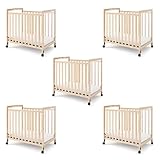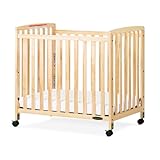Are Wooden Wheel Cribs Safe
Choosing a crib for your little one is a big decision, filled with anxieties and considerations. You want something beautiful, functional, and, most importantly, safe. This leads many parents to consider the charming aesthetic of wooden wheel cribs, but the question remains: are they safe? Let’s explore this in detail.
What are
Wooden Wheel Cribs?
Wooden wheel cribs are a stylish type of crib often featuring decorative wheels or wheel-like elements on the headboard or footboard. They’re typically made from wood, often a solid wood like pine or maple, but sometimes from manufactured wood products (MDF, particleboard). The design often evokes a vintage or rustic feel. The “wheels” are usually purely decorative, not functional in terms of mobility. The overall style can range from very traditional and ornate to more minimalist and modern. Their visual appeal is often a primary draw for parents, leading to many questions about safety.
Key Features and Variations
Wooden wheel cribs come in a wide variety of styles, sizes, and finishes. Some have elaborate carvings on the wheels, others sport simpler, more streamlined designs. The wood type, finish (paint, stain, varnish), and the overall construction will vary widely depending on the manufacturer and price point. Some may offer additional features like adjustable mattress height, built-in storage, or convertible options (changing to a toddler bed). However, these additional features need to be carefully examined for safety as well.
Comparing Wooden Wheel Cribs to Other Crib Types
When comparing wooden wheel cribs to other crib styles, like those made of metal or plastic, you need to focus on safety aspects. Metal cribs are usually known for their durability and ease of cleaning, but may lack the aesthetic charm of wood. Plastic cribs are lightweight and easily cleaned, but can be less aesthetically pleasing and potentially more prone to damage. The key difference and safety concern with wooden wheel cribs often stems from the potential for decorative elements, like the wheels themselves, to pose a hazard if not properly secured.
Safety Concerns with Wooden Wheel Cribs
Potential Hazards of Decorative Elements
The decorative wheels are the primary point of safety concern with these cribs. Loose parts, sharp edges, or small components that could detach and become choking hazards are serious risks. Inspect the wheels meticulously to ensure they are firmly attached and pose no risk of detachment. Look for any sharp edges or protruding pieces that could injure your baby. Always opt for cribs from reputable manufacturers that adhere to strict safety standards.
Material and Finish Considerations
The type of wood and its finish are also important considerations. Solid wood is generally considered safer than manufactured wood as it is less likely to contain harmful chemicals or to break down easily. However, even solid wood cribs need to be thoroughly checked for splinters or sharp edges. The finish should be non-toxic and child-safe, free of lead and other harmful substances. Look for certifications such as those from GREENGUARD Gold, indicating low levels of chemical emissions. Always check the manufacturer’s information and recommendations regarding appropriate cleaning methods.
Compliance with Safety Standards
It’s crucial that the crib meets or exceeds all relevant safety standards. In the United States, this means adhering to the standards set by the Consumer Product Safety Commission (CPSC). Look for certifications from reputable testing organizations and ensure the crib has passed all required safety checks. Avoid cribs that show signs of damage, poor construction, or lack necessary certifications. Check for labels indicating compliance with the CPSC’s standards, and be wary of cribs that lack such information or whose information is ambiguous.
Choosing a Safe Wooden Wheel Crib
Researching Manufacturers and Reviews
Before purchasing any crib, it’s essential to conduct thorough research. Check online reviews from other parents, focusing on their experiences with safety features and quality. Look for brands with a strong reputation for safety and customer satisfaction. Avoid unfamiliar brands or those with consistently negative feedback regarding safety concerns. Reading reviews can provide valuable insights into the practical experiences of other consumers.
Inspecting the Crib Before Purchase
Always inspect the crib carefully before making a purchase. Check for any loose parts, splinters, sharp edges, or potentially hazardous components, especially around the wheels and other decorative elements. Ensure that the mattress fits snugly, leaving no gaps that could create suffocation hazards. Make sure that all screws and bolts are tight. Test the stability of the crib to ensure it is sturdy and unlikely to tip over. If you have any concerns, don’t hesitate to ask the seller for clarification.
Maintenance and Care for Long-Term Safety
Regular maintenance is crucial to ensuring your child’s safety. Inspect the crib frequently for any signs of wear and tear, loose parts, or damage. Repair any damage immediately, or replace the crib if repairs cannot be made safely. Follow the manufacturer’s instructions for cleaning and maintenance to ensure the crib remains in good condition. Avoid using harsh chemicals that could damage the finish and create potential hazards.
Frequently Asked Questions
What are the most common safety hazards in wooden wheel cribs?
The most common hazards are loose parts, particularly those associated with decorative elements such as the wheels. Sharp edges, splinters, and small parts that could become choking hazards are also significant concerns. Check for these regularly.
How can I ensure my wooden wheel crib complies with safety standards?
Look for labels indicating compliance with CPSC standards. Research the manufacturer’s reputation and check for independent safety certifications from reputable testing organizations. Thoroughly examine the crib for any potential hazards before assembling and using it.
What are some signs that my wooden wheel crib is unsafe?
Loose or broken parts, damaged finishes, splinters, sharp edges, instability, or any component that easily detaches are all indications of an unsafe crib. Immediately discontinue use if any of these problems are observed.
Are there any specific materials or finishes I should avoid in a wooden wheel crib?
Avoid cribs made from materials known to contain harmful substances, such as lead-based paints. Always opt for finishes that are explicitly labeled as non-toxic and child-safe. Solid wood is generally preferred over manufactured wood products, as it is typically more durable and less prone to damage.
How often should I inspect my wooden wheel crib for safety issues?
Regular inspections are crucial. Aim to check your crib at least monthly for any signs of wear, loose parts, or damage. Before your baby uses the crib each time, give it a quick visual inspection.
Final Thoughts
Choosing a safe crib for your baby is paramount. While wooden wheel cribs can be aesthetically pleasing, their safety depends entirely on careful selection, thorough inspection, and ongoing maintenance. By following the guidelines outlined above and prioritizing safety features, you can ensure your child sleeps soundly and safely in their crib. Remember, a little extra vigilance goes a long way in ensuring your baby’s well-being. Don’t hesitate to research manufacturers, inspect the crib meticulously, and remain vigilant about potential safety hazards. Prioritize safety above all else when choosing a crib for your precious little one.

David Peterson, the chief editor of sparepartscare. I am an automobile engineer and assign to an local firm with much experience in automobile equipment. During the time, most of my experience is related to the Industry of cars parts. I learned about the thing, when working with experienced inspectors, one must be as good as the inspector, or better, with knowledge of the project as well as the practical aspects of automobile industry.








